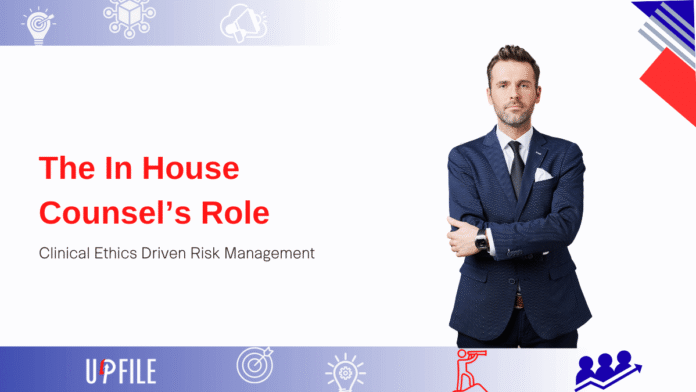Most health systems, and certainly most lawyers, perceive the need for legal services only when a catastrophic event occurs. A dispute. A lawsuit. A regulatory agency may issue a notice. Inside a health system, however, the best-performing legal teams are helping to create conditions to avoid disasters long before a courtroom is ever involved. They sit at the confluence of ethics and clinical care. They react quickly. They provide advice during periods of intense emotional pressure and short timelines.
As such, this concept may seem counterintuitive in a world where risk management typically occurs in response to problems, rather than as a preventative measure. However, it is successful in protecting patients, supporting clinicians, and creating trust within the system.
Steven Okoye, Esq., exemplifies this approach. Mr. Okoye is a corporate and healthcare attorney with firsthand experience in the value of integrating legal thinking into clinical ethics. His work illustrates that the most effective risk management occurs through collaborative efforts—not through the “firefighting” that often occurs with last-minute interventions.
Why Clinical Ethics Matters for Legal Risk Management
Clinical ethics is not a soft science; it is a practical tool. Every day, hospitals encounter questions without easy answers. End-of-life decision-making. Family conflict. Limited resources. Consent disputes are a common occurrence. The process involves making decisions about capacity. These issues can develop rapidly. Emotions become heightened. Family members become worried. Clinicians begin to feel pressured. An unclear conversation with the family can evolve into a serious complaint.
Legal departments often receive a case file much too late. By the time they receive the case file, all parties involved feel defensive. People often view the legal team as the “bearer of bad news.” As a result, the quality of the patient experience suffers.
There is a better way to manage the situation. Simply bring the legal and ethics teams together at the beginning. View ethics consultations as a type of frontline risk management. Use them to establish common ground before frustration develops.
Benefits of Collaborative Work Early On
Collaboration between attorneys and ethics committees creates a different atmosphere. It creates a slower pace. It emphasizes clarity over assigning blame. Attorneys learn the clinical context. Ethics committees learn the regulatory constraints. Together they establish options that protect both patient rights and institutional integrity.
It is important to note that the legal team is not directing clinical care. The legal team is offering perspective. The legal team is assisting clinicians in seeing how the decisions they make will be interpreted under applicable federal and state laws. The legal team is assisting families in understanding what the organization can and cannot do. The legal team is translating regulations into understandable language.
Steven Okoye, Esq., discusses the value of clear communication in his practice. In his experience, many disputes dissipate once families understand the logic behind the medical recommendations. People desire honesty. They desire consistent behavior. They desire assurance that their concerns are being considered. When the legal and ethics teams communicate early and straightforwardly, achieving these objectives becomes easier.
Converting Difficult Situations Into Manageable Decision-Making Processes
Consider an end-of-life dispute. A family may be demanding that the clinician perform a procedure that they believe will cause harm to the patient or extend the patient’s suffering. This is a difficult and emotionally charged situation for all parties. However, it is also an opportunity for ethics and legal teams to work together.
The ethics team can assist in outlining the underlying principles of the medical recommendation. The legal team can explain the patient’s rights and the organization’s obligations. A joint conversation helps establish alignment. Both sides are aware of the complete picture. A path toward agreement is created. Litigation is reduced.
Resource allocation is yet another area of contention. During peak demand seasons, hospitals must determine which patients receive priority for limited treatments. While this issue is primarily clinical, it also poses a legal risk if the allocation is inconsistent or poorly documented. Early collaboration results in policies that protect the hospital while remaining fair.
This is the essence of ethics-driven risk management. It provides structure to uncertainty. It provides direction when the circumstances surrounding a decision are imperfect.
How the Traditional Model Fails
Many hospitals consider legal and ethics work to be separate functions. Compliance is managed by the legal team. Values are managed by the ethics team. They rarely interact until there is a dispute already underway. This model delays problem resolution. It introduces tension. It assumes clean lines of demarcation exist in clinical decision-making, but they do not.
Patients do not perceive themselves receiving care in separate domains. Families do not distinguish between ethics and law. Their interests are intermingled with emotion, values, and rights. When an organization responds to their interests in parts, the patient experience is fragmented. The risk of adverse consequences increases.
An integrated model is perceived as calm. It is perceived as human. It is perceived as prepared. It also enhances staff trust. Clinicians have increased confidence in their decisions when they know that their good-faith actions have the support of the legal team. Ethics committees have additional tools available to facilitate clearer communications. Hospital administrators have earlier knowledge of potential risk areas.
A Contemporary Approach for a Changing Health Care Environment
Healthcare technology has allowed for the rapid delivery of clinical care. Patients have more access to information. Expectations of the public have evolved. Consequently, the previous “wait and respond” model for managing risks is no longer sufficient. Healthcare organizations require a system capable of anticipating points of friction and resolving them early on.
Attorney Steven Okoye’s work illustrates this transition. Attorney Okoye has observed how early legal guidance can simultaneously safeguard patients, employees, and the institution. Not through control. Through cooperation.
This creates a new purpose for in-house counsel. Counselors are not solely responsible for ensuring compliance with the law. They are partners who aid in converting uncertain clinical ethics into structured and predictable processes. They foster resilience. They enable hospitals to increase their ability to navigate challenging decisions by creating a framework for doing so.
Creating an Organization That Prevents Problems Before They Develop
In-house counsel can implement several basic strategies to cultivate this culture:
Schedule regular meetings with ethics committees. Review difficult cases. Discuss trends. Host brief educational sessions for clinical staff. Document their communications in a format that is accessible and conversational.
These practices produce significant results. They alleviate tension. They promote a collaborative mindset. They transform reactive risk management into proactive risk management.
The ultimate outcome is a calm, supportive clinical environment where clinicians feel empowered to deliver care. Patients feel heard. Families feel respected. The in-house counsel has become a strategic partner instead of a distant authority figure.
Final Thought
Ethics-driven risk management is not merely theoretical; it is a viable approach to reduce dispute frequency, enhance communication, and improve outcomes. Additionally, it provides a vehicle for demonstrating the true value of legal teams. Early. Proactively. Humane.
Attorney Steven Okoye exemplifies the potential impact of this approach. Attorney Okoye’s work exemplifies a fundamental principle: when ethics and legal teams collaborate, everyone benefits.




